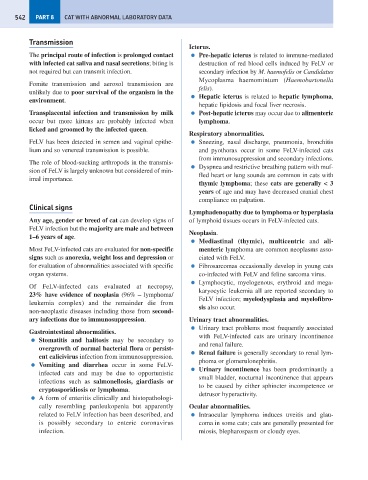Page 550 - Problem-Based Feline Medicine
P. 550
542 PART 8 CAT WITH ABNORMAL LABORATORY DATA
Transmission
Icterus.
The principal route of infection is prolonged contact ● Pre-hepatic icterus is related to immune-mediated
with infected cat saliva and nasal secretions; biting is destruction of red blood cells induced by FeLV or
not required but can transmit infection. secondary infection by M. haemofelis or Candidatus
Mycoplasma haemomintum (Haemobartonella
Fomite transmission and aerosol transmission are
felis).
unlikely due to poor survival of the organism in the
● Hepatic icterus is related to hepatic lymphoma,
environment.
hepatic lipidosis and focal liver necrosis.
Transplacental infection and transmission by milk ● Post-hepatic icterus may occur due to alimenteric
occur but more kittens are probably infected when lymphoma.
licked and groomed by the infected queen.
Respiratory abnormalities.
FeLV has been detected in semen and vaginal epithe- ● Sneezing, nasal discharge, pneumonia, bronchitis
lium and so venereal transmission is possible. and pyothorax occur in some FeLV-infected cats
from immunosuppression and secondary infections.
The role of blood-sucking arthropods in the transmis-
● Dyspnea and restrictive breathing pattern with muf-
sion of FeLV is largely unknown but considered of min-
fled heart or lung sounds are common in cats with
imal importance.
thymic lymphoma; these cats are generally < 3
years of age and may have decreased cranial chest
compliance on palpation.
Clinical signs
Lymphadenopathy due to lymphoma or hyperplasia
Any age, gender or breed of cat can develop signs of of lymphoid tissues occurs in FeLV-infected cats.
FeLV infection but the majority are male and between
Neoplasia.
1–6 years of age.
● Mediastinal (thymic), multicentric and ali-
Most FeLV-infected cats are evaluated for non-specific menteric lymphoma are common neoplasms asso-
signs such as anorexia, weight loss and depression or ciated with FeLV.
for evaluation of abnormalities associated with specific ● Fibrosarcomas occasionally develop in young cats
organ systems. co-infected with FeLV and feline sarcoma virus.
● Lymphocytic, myelogenous, erythroid and mega-
Of FeLV-infected cats evaluated at necropsy,
karyocytic leukemia all are reported secondary to
23% have evidence of neoplasia (96% – lymphoma/
FeLV infection; myelodysplasia and myelofibro-
leukemia complex) and the remainder die from
sis also occur.
non-neoplastic diseases including those from second-
ary infections due to immunosuppression. Urinary tract abnormalities.
● Urinary tract problems most frequently associated
Gastrointestinal abnormalities.
with FeLV-infected cats are urinary incontinence
● Stomatitis and halitosis may be secondary to
and renal failure.
overgrowth of normal bacterial flora or persist-
● Renal failure is generally secondary to renal lym-
ent calicivirus infection from immunosuppression.
phoma or glomerulonephritis.
● Vomiting and diarrhea occur in some FeLV-
● Urinary incontinence has been predominantly a
infected cats and may be due to opportunistic
small bladder, nocturnal incontinence that appears
infections such as salmonellosis, giardiasis or
to be caused by either sphincter incompetence or
cryptosporidiosis or lymphoma.
detrusor hyperactivity.
● A form of enteritis clinically and histopathologi-
cally resembling panleukopenia but apparently Ocular abnormalities.
related to FeLV infection has been described, and ● Intraocular lymphoma induces uveitis and glau-
is possibly secondary to enteric coronavirus coma in some cats; cats are generally presented for
infection. miosis, blepharospasm or cloudy eyes.

